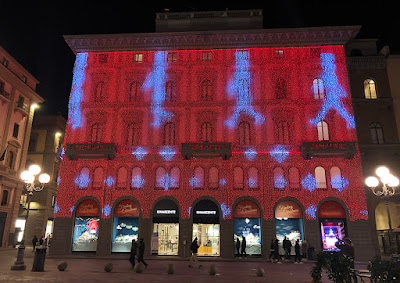There are not too many light art festivals that I have an urge to visit again, but Arvika Ljus! is definitely one of them. Let me tell you why.
 |
| Ainu Palmu's Dove, Hope is about light, shadow and change |
Arvika Ljus! is art, not spectacle. I’m not “magically amazed” as seems to be the objective of many light art festivals. Rather, I’m surprised, challenged, and fascinated. The artworks are carefully curated and every one of them has a reason to be there. Even if they don’t share an exact theme, material or style, the whole is coherent, and the spirit of the artworks support each other.
The artworks are fluently site sensitive. Not all of them are planned to the places they are exhibited in, but all the sites have been carefully and intentionally chosen, giving the artworks a relation to the space. The festival is human size and cozy. But not too hygge, also some darker sides of life are dealt with.
Next time I visit, I have reason to believe I’ll be seeing something new. I don’t mean that every art piece will be not-seen-before, but they will not be a roster of flashy artworks that could be part of any festival, either. I’m sure I’ll recognise the same solid base of artistic endeavor, but the angle will be different. It will be a light art exhibition I don’t see anywhere else.
 |
| Lin de Mol's Individual Anarchy deals with often misinterpreted urban phenomena of thrown away sneakers © Lin de Mol |
This year, there are nine artworks, which I think is a perfect number to concentrate on each and still be able to see them in one night. I do recommend staying in Arvika a little longer, though, it is a town well worth a visit in its own right. It has an ample variety of odd spaces to fill with light art, and seeing the artworks is also a good way of seeing the town. You may want to start your tour in Elins Bakgård café. Just saying.
 |
| An urban campfire |
 |
| All of a sudden I had an urge to organize a miniatyre light art festival. Wonder why. |
 |
| This place is so wrong and thus so absolutely right for this artwork |
The (physically) largest artwork in the festival must be Fluxit by Vendel & de Wolf. It is a flickering campfire, balancing between nostalgic memories of a scout life past and a vision of future, where even the forest fires will not be real. The smallest artwork is just the size of a matchbox, quite literally. It also combines nostalgia and artificiality, though more consciously. Artificial Truth by Merijn Bolink is a diptych of two differently sized matchboxes, whose labels we all recognize from our memories. Or so we think. They are actually drawn by AI, heavily influenced by old matchbox labels. When looked up close, the images on them are quite Dadaistic and just barely figurative.
 |
| This is not, I repeat not Christine |
I’ve seen Anne Roininen’s Car Show four times in four different locations, and it just doesn’t get old. It always expresses a new kind of commentary to the place it finds itself. The obviously haphazardly parked cars, filled with smoke and colours, have a distinct personality themselves, but they also make me wonder what kind of being has left them where they are.
This innocent-looking artwork became a kind of a scandal. The city management was called several times with reports of a dangerous, possibly exploding car. So much so, that a this-is-just-art-it-will-not-explode-I-promise kind of a sign had to be attached to the piece. I could snicker, but I rather find it quite endearing that Arvika folks look after their town.
 |
| A good point from Felice Hapetzeder |
The festival is curated by Lin de Mol, also a wonderful artist and a demonstrated super woman. Another reason to come back is that I really want to see what will be the third part of de Mol’s light art triptych after glowing suitcases and shoes, but she wouldn’t tell.
I'm betting... Falukorv?











































